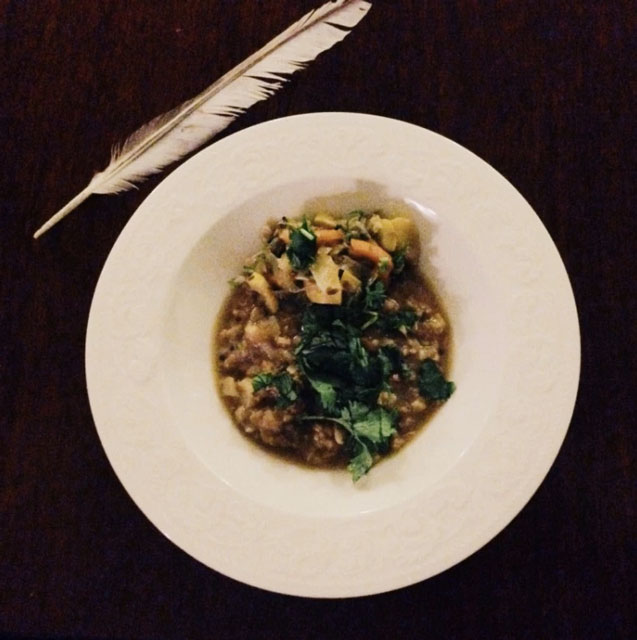
“Cooking is at once child’s play and adult joy. And cooking done with care is an act of love.” ~ Craig Claiborne
If you don’t cook daily or often, cooking can often seem laborious.
Yet if you look at it as a way of creating nourishment for yourself and those you love, it becomes an act of mindfulness.
Here’s what I love about cooking: it’s focused alchemy. You take a few ingredients, you add heat, or some other force, and a lot of love and magic (usually) happens.
And you know what? It’s grounding, especially when you have willing helpers who clean up. (I manage to use a lot of pots—or so my husband says.)
Stirring something on the stove is probably one of the simplest pleasures in life. A luxury, really, because it takes time and time is such a precious commodity these days.
We have a child so we keep things simple.
I focus on using lots and lots of fresh, local and seasonal vegetables in our food, whole grains and when we have meat, portions are small and the meat is always free range and pasture-fed, while fish is always wild.
Now the thing about Santa Cruz, where we’ve been living for the last while, is that even though it gets ridiculously hot and dry here during the midday, it also gets cool at night. The climate is more desert-like than in the Pacific Northwest and that extreme variation in Ayurvedic terms is known as Vata especially as we move into the winter. Vata is the wind or air element and when out of balance it can cause many issues, quickly.
To understand Vata, think about the effect of Fall on perennial trees—the leaves dry, rustle and fall down, while the wood literally dries out.
It’s exactly what happens to our skin when it’s cold and dry: we lose moisture and juiciness physically, mentally and emotionally. If we have lot of the Vata element within us to begin with, we may start to feel agitated and anxious, which are all signs that we have a Vata “imbalance.”
The goal of Ayurveda is to live in harmony with nature and its natural rhythms.
Seasonally, this means as we move into the cooler, drying months of the year (in most places in the Northern Hemisphere, barring the Pacific Northwest that is); we must start to take precautions against both drying out too much as well as losing heat.
It all comes down to realising that everything in the external environment directly impacts our inner environment or our internal ecology.
A really easy way to understand this is that in the winter, when the sun’s energy is diminished, our outer world becomes much colder. Similarly, says Ayurveda, internally, we also lose our inner “sun” heat, or digestive fire, Agni. Given this fact, we must start to shift the way we eat.
While raw, green salads and foods that are more taxing on the digestive system may be fine in the summer, that’s not the case in the winter—I usually notice that as soon as the weather turns, I crave soups and stews.
Food in Ayurveda is the foundation of every other healing therapy and a big part of our health “routine” is learning to listen to our gut, to our true intuition. Eating seasonally is also key.
One of my favourite, fall-into-winter comfort foods is khichadi. Also known as khichari, “kitchree,” Khichadi has been Indian peasant food for centuries.
A stew of split mung dal along with basmati rice, khichadi is said to have all six tastes: sweet, sour, salty, bitter, pungent and astringent. According to Ayurveda, if we have all six tastes present in every meal, we balance our system and become healthy.
Basmati rice and mung dal both have the qualities of being sweet and cooling with a sweet aftertaste, but the warming spices help to moderate the sweet, coolness of the rice and dal, which makes khichadi easy to digest for almost everyone, even those with low digestive fire in a fortifying combination of protein and grains that is easily absorbable by our cells. In texture it is gooey and stewy, similar to Chinese Congee; and every region of India has a local variation with the addition of a few vegetables and different spices. I tend to use whatever vegetables are in season while my blend of spices is always a little bit fluid. For something as simple as a combination of rice and lentils, it has a lot going on and if you decide to make it on your own, I think you’ll see exactly why.
Here is a fool-proof recipe to make khichadi at home. It’s endlessly customisable—I’ve asked my mother for recipes for years and all I get is a pinch of this and a pinch of that—but that is exactly how recipes were passed down by the women in my family. I encourage you to play with different vegetable combinations and come up with a few of your favourites. Savour every mouthful!
Warming Winter Khichadi: A Recipe.
Ingredients:
ghee: 1 – 2 tbsp.
spices:
1/8 – 1/4 tsp. turmeric powder
1 bay leaf (warming and tonifying)
1 tsp. mustard seeds (warming, increases digestive fire)
1/2 tsp. fenugreek (warming and bitter, increases digestive fire)
1 tsp. cumin seeds (digestive, anti-inflammatory)
2 – 3 pods cardamom (tonifying and astringent)
1 pinch asafoetida powder (allows us to digest lentils ease fully, i.e. eases gas or bloating)
1 inch grated fresh ginger (warming)
veggies + lentils + rice:
1/2 onion, diced
1 – 2 cups of chopped fresh vegetables (use whatever is seasonal and, needless to say, organic)
1 cup basmati rice
1/2 cup mung beans (shelled, split-yellow colour)
6 cups of boiling water
a few cilantro leaves, finely chopped to garnish
Method:
1. Dry roast the spices, except for the fresh ginger, in a pan for a few minutes until toasted.
2. In a large pot, warm on medium high heat, 1 – 2 tbsp. of ghee. Add the spices.
3. Wait until the cumin and mustard seeds pop, then quickly add fresh ginger and onions and sauté.
4. Add soaked rice and lentil mixture, stir for a few minutes, then add the water.
5. Cook over medium heat uncovered until the water is absorbed, then add 1 additional cup water.
6. Reduce the heat to low, cover and cook for 5 minutes. At this point you can add the chopped vegetables and let the entire stew cook until moist and soft. It could take another 1/2 hour to an hour. You can stir it occasionally, but you don’t need to. Just be sure it doesn’t burn.
Serve with a vegetable chutney and perhaps a little bit of warm ghee for added moistness. Enjoy!
~
Author: Insiya Rasiwala-Finn
Image: Courtesy of the author
Editor: Katarina Tavčar






Read 0 comments and reply